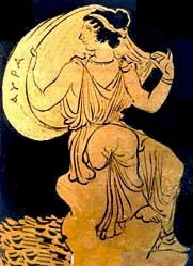Nymph facts for kids
A nymph is a special kind of female nature spirit or being in Greek mythology. They are often seen as companions or helpers of the Greek gods and goddesses. Nymphs are usually very beautiful and live in natural places. They are not immortal like the gods, but they can live for a very long time.
Contents
Types of Nymphs
Nymphs are often named after the natural places they live in or are connected to. There are many different kinds of nymphs, each with their own special home.
Dryads: Spirits of Trees
Dryads are nymphs who live in trees. They are closely connected to their trees. If their tree dies, the dryad often dies too. They are known for protecting forests and woodlands.
Naiads: Guardians of Fresh Water
Naiads are nymphs of fresh water. They can be found in rivers, lakes, springs, and wells. Naiads are often seen as guardians of these water sources, which were very important for ancient people.
Oreads: Nymphs of the Mountains
Oreads are the nymphs of mountains and caves. They are often found roaming the high peaks and rocky slopes. They are sometimes associated with the goddess Artemis, who loved to hunt in the mountains.
Okeanids and Nereids: Nymphs of the Sea
The Okeanids are the many daughters of the powerful Titan god Okeanos, who was the god of the world-encircling ocean river. They represent different aspects of the sea. The Nereids are the daughters of Nereus, an old sea god. They are often seen playing in the seas and are known for their beauty and grace. One famous Nereid is Thetis, the mother of the hero Achilles.
Pleiades: Nymphs of the Stars
The Pleiades are a group of seven sisters who were nymphs. After they died, they were placed in the sky as a group of stars. They are often associated with the goddess Artemis and the god Zeus.
Role in Greek Mythology
Nymphs play many different roles in Greek myths. They are often attendants to gods and goddesses, like Artemis (goddess of the hunt) or Dionysus (god of wine). They can also be involved in stories with heroes or even fall in love with mortals. Sometimes, they are helpful and kind, but other times they can be mischievous or even dangerous to humans who disturb their natural homes.
Images for kids
-
A Sleeping Nymph Watched by a Shepherd by Angelica Kauffman, about 1780, (V&A Museum no. 23-1886)
-
Nymphe by Gaston Bussière (1929)
See also
 In Spanish: Ninfa para niños
In Spanish: Ninfa para niños





